We may not have the course you’re looking for. If you enquire or give us a call on +44 1344 203 999 and speak to our training experts, we may still be able to help with your training requirements.
Training Outcomes Within Your Budget!
We ensure quality, budget-alignment, and timely delivery by our expert instructors.
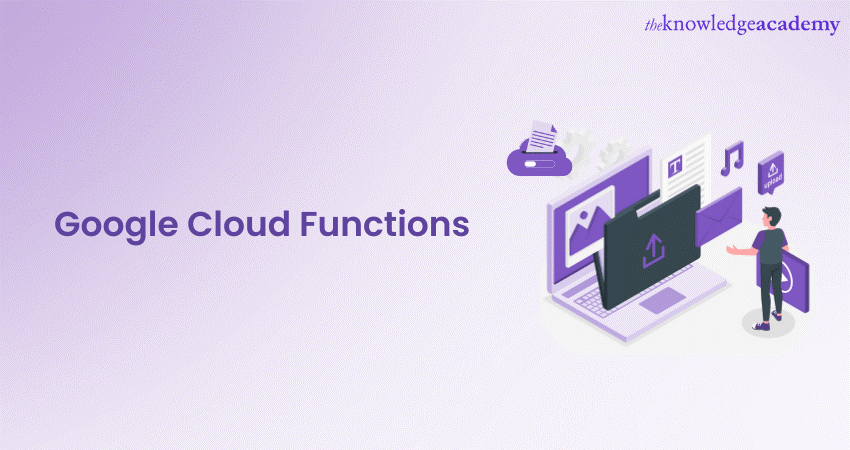
Serverless architectures have quickly become popular because they scale easily and save costs. One of the top players in this space is Google Cloud Functions, which lets developers run code without worrying about managing servers. It streamlines the entire process of building and deploying applications, making it much easier for developers.
With Google Cloud Functions, you can run your code in response to events without setting up or maintaining any servers. If you haven’t started using this service yet, now’s the time to jump on board. But how exactly does it work? What makes Cloud Functions a powerful tool, and how can it drive real change for your projects? In this blog, we’ll cover the basics of Google Cloud Functions, with examples to show you how they work in real-life scenarios. Ready to dive in? Let’s get started!
Table of Contents
1) What is Google Cloud Functions?
2) Key Concepts of Google Cloud Functions
3) Types of Google Cloud Functions
4) Benefits of GCF
5) How Google Cloud Functions Works
6) Setting up Google Cloud Functions
7) Creating your first Google Cloud Functions
8) Google Cloud Functions Example
9) Cloud Functions Best Practices
10) Conclusion
What is Google Cloud Functions?
Google Cloud Functions is a serverless execution environment provided by Google Cloud Platform (GCP). It allows developers to run individual units of code in response to specific events without the need to manage servers or infrastructure. These units of code are known as Functions. This serverless architecture eliminates the burden of server provisioning, scaling, and maintenance. This enables developers to focus solely on writing code and building applications.
The term "serverless" may be misleading, as it doesn't mean there are no servers involved. Instead, it means that developers do not directly deal with the server management aspects. Google Cloud abstracts the underlying infrastructure, automatically scaling the Functions based on the incoming load. It helps to optimise resource utilisation and reduce costs.
Key Concepts of Google Cloud Functions
Let’s have a look at the key concepts of Google Cloud Functions:
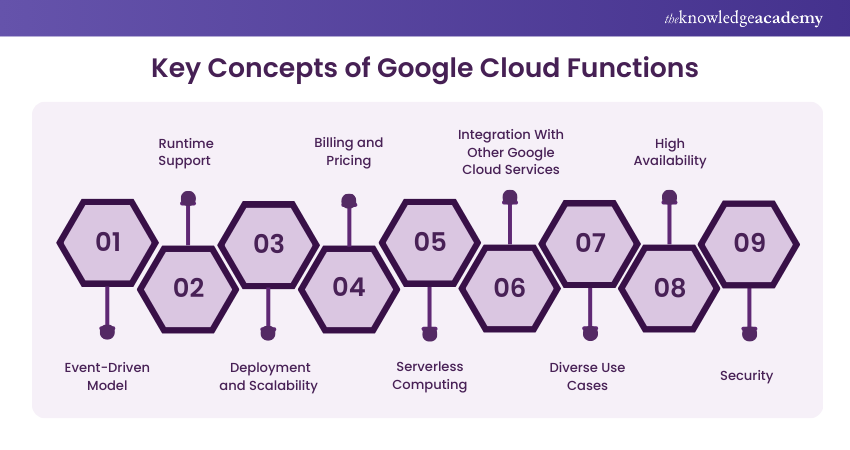
a) Event-Driven Model: First important concept is that it follows an event-driven model where functions are executed upon triggering specific events or actions. These are events that can be originated by many services of GCP like Http Request, Pub/Sub Messages, Cloud Storage Changes (Bucket Notification), Firestore Events, and so on. Developers can define functions to handle these events and specify the event sources.
b) Runtime Support: Cloud Functions can be built with a variety of programming languages including Node.js and Python. JavaScript (Node jsonify) — Latest as of my writing.djangoproject 2.1, Django REST framework 3toHaveBeenCalledTimes on the server side js), Python, Go,. NET, Ruby, and Java.
c) Deployment and Scalability: It is easy to deploy functions on the Cloud Functions. You can use the gcloud command-line tool to deploy your apps or integrate with CI/CD pipelines for automated deployments. The platform seamlessly scales functions as needed, making sure the app remains durable under any conditions of sudden traffic increase.
d) Billing and Pricing: Cloud Functions use pay-as-you-go-based pricing which means that developers are billed based on the number of activations for each function plus the time those functions take to execute. Users only pay for what they use, this pricing model is economical in case of low utilisation applications.
e) Serverless Computing: A computing platform in which developers can execute code without having to manually manage the underlying infrastructure. This allows app developers to focus on code creation and execution and leave the management of infrastructure off their task list since it is all handled by the platform itself. This way, more easily deployable applications can lead to quicker scaling for your infrastructure automatically as well (also based on demand).
f) Integration With Other Google Cloud Services: As a part of GCP, called ''Google Cloud Functions'' that integrates with many other services provided by the Google-cloud platform, giving it the usage capabilities of building more complex applications which require multiple services. The integration includes, for instance, Google Cloud Services, but also services of the like Cloud Pub/Sub and Cloud Firestore. This interoperability opens opportunities for developers to deliver more holistic solutions by using the capabilities of these integrated services.
g) Diverse Use Cases: It is also used for versatile application development which means you can create a broader range of applications. This Service can be used by Developers to create functions like webhooks, chatbots, data processing pipelines, etc. Its pliability and an event-driven architecture make it a suitable candidate for many use cases not limited to webhooks (for seamless integrations), interactive chatbots, or even building high-throughput data processing pipelines.
h) High Availability: It provides a high service level that Google Cloud Functions ensures the cross-zone redundancy for functions by failing-over to other unimpacted zones automatically. This provides for higher availability (more redundant, less prone to failures or disruptions in any given availability zone) and lower Total Impactful Downtime that your customers will try experience. The high availability aspects are targeted to cater you 100% with no downtime. It is also in line with the high-availability requirements usually demanded by cloud infrastructures.
i) Security: It offers the security on message level, like secure connections and authorisation mechanisms. These native security measures can be utilised by developers to protect their code and data on the platform. Furthermore, you can apply some security plugins that suit your needs with Google Cloud Functions because it is flexible! This holistic strategy is the foundation of security that makes application users confident in Google Cloud Functions.

Types of Google Cloud Functions
Google Cloud Functions are categorised into two distinct types: HTTP Functions and Event-driven Functions. Let's have a detailed look at these types:
1. HTTP Functions: HTTP functions are invoked through standard HTTP requests, waiting for responses. The following are some of its sub-types:
a) Supported Methods: Handles standard HTTP request methods, including GET, PUT, POST, DELETE, and OPTIONS.
b) TLS Certificate: Automatically provides a TLS certificate, allowing secure invocation via HTTPS.
c) Security: Facilitates secure communication over HTTPS for all HTTP functions.
2. Event-Driven Functions: These manage events from the Cloud infrastructure, such as Pub/Sub messages or changes in a Cloud Storage bucket. The sub-types of event-driven functions are as follows:
a) Background Functions: Written for Node.js, Python, Go, and Java runtimes, these functions respond to background events.
b) CloudEvent Functions: Specifically for the .NET Cloud Functions runtime, responding to CloudEvents.
Benefits of GCF
Google Cloud Functions (GCF) offers a seamless way to build and deploy lightweight functions with minimal management overhead. It’s an ideal choice for developers looking to create high-performing applications quickly and cost-effectively. Let us have a look at the key benefits of GCF:
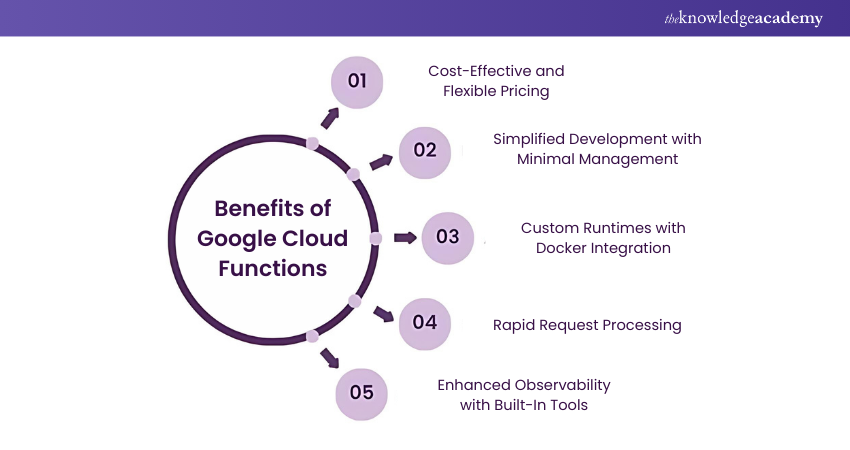
1) Cost-Effective and Flexible Pricing:
Google Cloud Functions (GCF) offers a budget-friendly solution with flexible pricing. Costs are directly tied to your usage, allowing you to scale up or down without the burden of paying for unused capacity. This pay-as-you-go model ensures you only spend on what you need.
2) Simplified Development with Minimal Management:
If you’re aiming to build lightweight, high-performance functions without the hassle of server management, GCF is a solid option. It takes care of the infrastructure, so you can focus solely on writing your code, freeing you from administrative tasks.
3) Custom Runtimes with Docker Integration:
GCF allows the creation of custom runtimes using Docker images, offering immense flexibility. This feature leverages Docker’s popularity and robust documentation, making it easier to integrate GCF into other containerised environments. This capability provides a seamless, unified approach to deploying and managing applications.
4) Rapid Request Processing:
Known for its speed, GCF excels at processing individual requests quickly, making it ideal for applications where performance is key. It’s designed to handle HTTP requests by default, providing versatile hosting that isn’t tied to rigid usage plans, giving you the freedom to build responsive, scalable apps.
5) Enhanced Observability with Built-In Tools:
GCF integrates with tools like Cloud Debugger and Cloud Trace, enhancing your ability to monitor and diagnose code issues. These tools provide deep insights into your application’s performance, helping you swiftly address and resolve problems as they arise, ensuring smooth, uninterrupted service delivery.
Master the basics with our Google Cloud Platform Fundamentals Course - start your cloud journey today!
How Google Cloud Functions Works?
Google Cloud Functions (GCF) is a serverless platform that simplifies application development by running code in response to events and automatically managing resources. It offers scalable, pay-as-you-go solutions, supporting multiple languages and seamless integration with other cloud services.
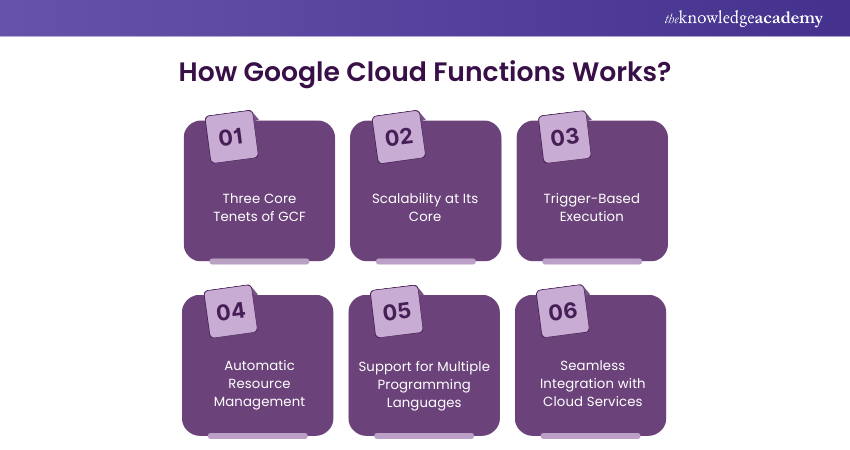
1) Three Core Tenets of GCF:
Google Cloud Functions (GCF) operates under three core principles that enhance flexibility, ease of use, and cost efficiency:
a) Simplified Developer Experience: GCF streamlines development by providing an intuitive environment, allowing developers to focus on coding without worrying about infrastructure.
b) Avoiding Vendor Lock-In: It uses open-source technologies, offering flexibility and portability to build applications without being confined to a single cloud provider.
c) Pay-as-You-Go Model: GCF charges based on actual usage, making it a cost-effective choice for businesses with varying workloads.
2) Scalability at Its Core:
GCF excels in scalability, automatically adjusting to workload demands. As a Function-as-a-Service (FaaS) platform, it dynamically spins up and down instances based on the current activity level. If the number of requests spikes, GCF rapidly deploys additional instances to handle each incoming request, ensuring performance remains consistent without manual intervention.
3) Trigger-Based Execution:
The platform allows teams to create applications that run code in response to specific triggers or events. This event-driven architecture supports a wide range of triggers, such as HTTP requests, database changes, or messages from other services, making it versatile for various use cases.
4) Automatic Resource Management:
GCF handles all the underlying computing resources required for your applications, including provisioning, scaling, and load balancing. This hands-off approach relieves DevOps teams from the complexities of infrastructure management, allowing them to dedicate their efforts to developing and deploying new features.
5) Support for Multiple Programming Languages:
GCF supports a variety of popular programming languages, including Node.js, Python, Go, Java, .NET, Ruby, and PHP. This multi-language support allows teams to use their preferred coding languages, enhancing productivity and reducing the learning curve associated with adopting new technologies.
6) Seamless Integration with Cloud Services:
Functions created on GCF can easily integrate with other Google Cloud services, like Cloud SQL and Bigtable, enabling seamless connections across various data and application layers. This integration capability simplifies the process of building complex, interconnected applications that leverage the full power of cloud ecosystems.
Setting up Google Cloud Functions
To start using Cloud Functions, you need to have a Google Cloud Platform (GCP) account and create a new project. You can use Google Cloud Functions to integrate Google data actions, but their use requires special processing. The following steps outline the setup for using functions with the integration of Google data actions.
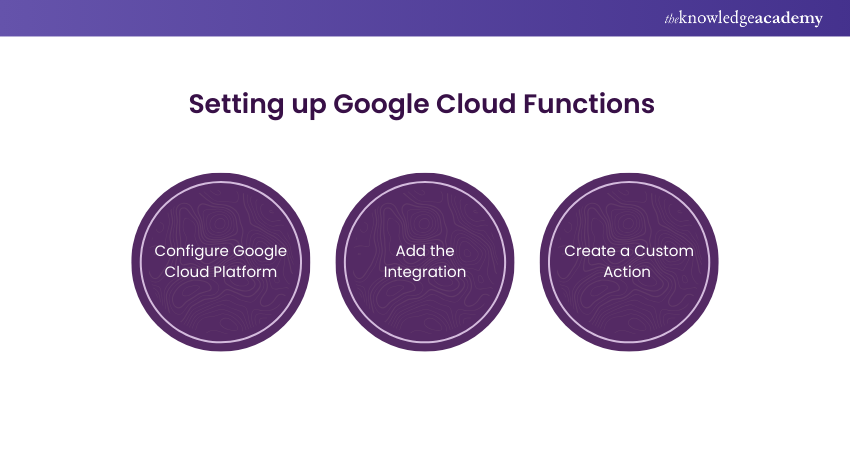
1) Configure Google Cloud Platform.
You will add the service accounts and create private key files, and you will have to configure functions, roles, and permissions.
2) Add the Integration.
Add an integration for each service account added in the Google Cloud Platform. If you would like to use multiple APIs in the Google Cloud Platform that span across Service Accounts, then you should create separate integrations for these Service Accounts.
3) Create a Custom Action.
You can create actions that can execute Google Cloud Functions. Creating this action, therefore, means being able to configure it with special inputs.
Take your app development to the next level with our Developing Applications With Google Cloud Platform Course - sign up now!
Creating Your first Google Cloud Functions
Let's create a simple "Hello World" Function using Node.js that will be triggered via an HTTP request.
|
// index.js exports.helloWorld = (req, res) => { res.send("Hello, World!"); }; Deploying the function to Google Cloud: gcloud functions deploy helloWorld --runtime nodejs14 --trigger-http |
Now, you can invoke this first Google Cloud Function by sending an HTTP request to the URL provided during deployment.
Elevate your Data analytics skills with our Google Advanced Data Analytics Professional Training Course – Sign up now!
Google Cloud Functions Example
To demonstrate the versatility of Cloud Functions, let's create an example of “image processing”. The Cloud Storage trigger will be used to automatically generate thumbnails whenever an image is uploaded to a specific bucket.
|
// index.js const { Storage } = require('@google-cloud/storage'); const sharp = require('sharp'); exports.generateThumbnail = async (event, context) => { const { name } = event; const storage = new Storage(); const bucket = storage.bucket('your-bucket-name'); const file = bucket.file(name); const thumbnailName = `thumbnails/${name.split('/').pop()}`; const thumbnailFile = bucket.file(thumbnailName); await file.download(); await sharp(name).resize(200, 200).toFile(thumbnailName); return `Thumbnail ${thumbnailName} created successfully!`; }; |
Deploying the Function:
gcloud Functions deploy generateThumbnail --runtime nodejs14 --trigger-resource your-bucket-name --trigger-event google.storage.object.finalize
Now, whenever an image is uploaded to the specified bucket, the generateThumbnail Function will automatically create a thumbnail of the image.
Use Cases
Cloud Functions caters to a wide range of use cases, providing a versatile platform for serverless development. Some common use cases include the following:
a) Webhooks and API Endpoints: Cloud Functions can serve as webhooks or API endpoints, allowing easy integration with external services and systems. These functions can handle incoming requests, process data, and trigger subsequent actions.
b) Data Processing: With its seamless integration with Pub/Sub, Cloud Functions can efficiently process and transform data from various sources. It is particularly useful for real-time data processing and data pipelines.
c) Automation and Scheduled Tasks: Developers can schedule Cloud Functions to run at specific intervals using Cloud Scheduler. This makes it ideal for automating repetitive tasks, such as data backups, report generation, or database cleanup.
d) Internet of Things (IoT) Applications: Cloud Functions can be utilised to process data from IoT devices, analyse sensor data, and trigger actions based on certain conditions.
e) Mobile and Web Backend: As a serverless backend, Cloud Functions can power mobile and web applications by handling user authentication, processing user-generated content, and managing backend logic.
Master Big Data Analysis with our Data Engineering With Google Cloud Platform Course -Join today!
Cloud Functions Best Practices
Cloud Functions has many best practices. Some of them are mentioned below.
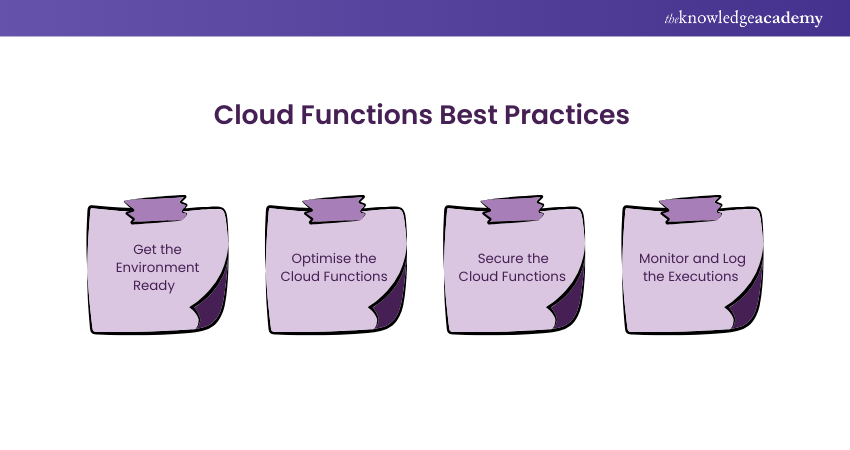
1) Get the Environment Ready
It is important to have the correct structure to start with solid foundations before getting ready to scale. Similarly, it is also important to use the appropriate tools and the right development process before deploying a single Cloud Function. It will help you save hours, have a clearer structure, and be ready to deploy multiple functions in multiple languages efficiently.
2) Optimise the Cloud Functions
Once the environment is ready, development and deployment are so easy that it’s tempting to deploy multiple Functions that have common code.
3) Secure the Cloud Functions
With efficient Cloud Functions running, it’s essential to keep them safe and protect them. Now, we will have a deep look into Cloud Functions permissions and security differences between background functions, oAuth authentication and API key authentication.
4) Monitor and Log the Executions
Once we developed secured functions efficiently, we might have no idea if it went well or if it crashed. Therefore, to have metrics, notifications, a deep vision inside the executions while staying outside, we need to set up monitoring tools and log efficiently.
Unlock new opportunities with Python With Google Cloud Platform Training - start your journey with us now!
Conclusion
Amid the vast landscape of cloud computing, Google Cloud Functions shines as a versatile tool for developers looking to build powerful, event-driven applications without the hassle of server management. By diving into its details, you can create scalable, event-driven apps without worrying about infrastructure management. With a diverse set of triggers and a fully managed environment, Google Cloud Functions empowers you to build efficient, cost-effective solutions that meet your needs.
Unlock the power of Google Cloud with our Architecting Infrastructure With Google Cloud Platform Training!
Frequently Asked Questions

Google Cloud Functions and AWS Lambda are both serverless platforms, but they differ in ecosystems and integrations. GCF integrates deeply with Google Cloud services, while Lambda integrates with AWS services. GCF supports more event triggers, and each has unique language support and regional availability.

GCP Cloud Functions is a serverless FaaS platform for running event-driven code snippets, while App Engine is a PaaS for deploying and scaling entire applications. Cloud Functions are stateless and scale automatically per request, whereas App Engine provides more control over application configuration, scaling, and state management.

The Knowledge Academy takes global learning to new heights, offering over 30,000 online courses across 490+ locations in 220 countries. This expansive reach ensures accessibility and convenience for learners worldwide.
Alongside our diverse Online Course Catalogue, encompassing 17 major categories, we go the extra mile by providing a plethora of free educational Online Resources like News updates, blogs, videos, webinars, and interview questions. Tailoring learning experiences further, professionals can maximise value with customisable Course Bundles of TKA.

The Knowledge Academy’s Knowledge Pass, a prepaid voucher, adds another layer of flexibility, allowing course bookings over a 12-month period. Join us on a journey where education knows no bounds.

The Knowledge Academy offers various Google Cloud Certification, including Google Cloud Platform Fundamentals Course, Architecting Infrastructure with Google Cloud Platform Training, and Data Engineering with Google Cloud Platform Training. These courses cater to different skill levels, providing comprehensive insights into Cloud Computing Platforms
Our Cloud Computing Blogs cover a range of topics related to Microsoft Excel, offering valuable resources, best practices, and industry insights. Whether you are a beginner or looking to advance your Excel skills, The Knowledge Academy's diverse courses and informative blogs have you covered.







 Top Rated Course
Top Rated Course



 If you wish to make any changes to your course, please
If you wish to make any changes to your course, please


